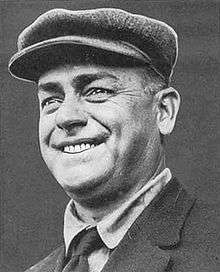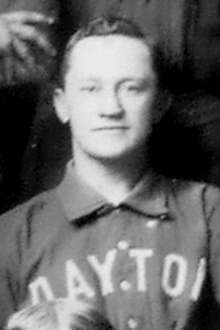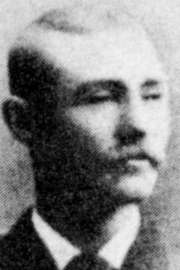Nashville Tigers
|
Nashville Tigers 1893–1894 Nashville, Tennessee | |
| Class-level | |
|---|---|
| Previous | Class B |
| Minor league affiliations | |
Previous leagues | Southern League |
| Major league affiliations | |
| Previous | Unaffiliated |
| Minor league titles | |
| Pennants (1) |
1894 (Second-half)* *The Tigers were in first place in the second-half standings when the league disbanded.[1] |
| Team data | |
| Nickname | Nashville Tigers |
| Ballpark | Athletic Park |

The Nashville Tigers were a minor league baseball team that played in the Class B Southern League from 1893 to 1894. They were located in Nashville, Tennessee, and played their home games at Athletic Park. The Tigers are credited with playing the first night baseball game in Nashville on July 6, 1894.[2]
Team history
1893 Season
After the Nashville Blues left the Class B Southern League following the 1887 season, Nashville was without a professional baseball team for five years. That changed in 1893 when the Nashville Tigers joined the Southern League.[3] The 12-team circuit also included the Atlanta Windjammers, Augusta Electricians, Birmingham Grays/Blues, Charleston Seagulls, Chattanooga Warriors, Macon Central City/Hornets, Memphis Fever Germs, Mobile Blackbirds, Montgomery Colts, New Orleans Pelicans, and Savannah Electrics/Rabbits.[4] The Tigers played their home games at Athletic Park, which would later come to be known as Sulphur Dell. The Tigers were managed by former major league player and manager Ted Sullivan in their inaugural season.[5]
Before the season started, a number of Southern League teams, including Nashville, participated in exhibition games against clubs from the National League. On March 24, the Tigers faced the St. Louis Browns, a 9–0 loss which Nashville forfeited.[6] That April, they participated in a two-game exhibition series against the Baltimore Orioles.[7] In the first game of the series, Baltimore's George Treadway hit a double, scoring John McGraw in the first inning. Tredway added to their lead with a home run in the sixth. McGraw was hit by a pitch in the eighth and later scored on Harry Stovey's triple. The Orioles outscored Nashville by a final tally of 3–0.[7] During the fourth inning of the next day's game, the umpire was removed due to the Baltimore club disagreeing with some of his calls. He was replaced by Tom Vickery, Nashville's pitcher from the previous day's contest.[7] The game was called in the ninth inning due to darkness, resulting in a tie score (9–9).[7]
The Tigers finished the first half of the season, called the first series, in twelfth (last) place with a 20–44 (.313) record.[4] Financial problems forced Nashville's owners, as well as those of the Birmingham Grays/Blues and the Charleston Seagulls, to surrender their teams to the league,[8] which continued to operate the clubs.[9] Continuing league-wide financial problems forced a premature end to the season on August 12.[8] Their second series record was an improvement over the first, having compiled a 13–16–3 (.448) record, earning them an eighth-place finish.[4] Overall, the team finished last with a 33–60 (.355) record.[10]
Record vs. opponents
| 1893 Nashville record vs. opponents[11] | |||
|---|---|---|---|
| Team | First series | Second series | Composite |
| Atlanta | 1–5 | 0–0 | 1–5 |
| Augusta | 1–5 | 0–0 | 1–5 |
| Birmingham | 3–3 | 4–2 | 7–5 |
| Charleston | 0–6 | 0–0 | 0–6 |
| Chattanooga | 2–4 | 0–0 | 2–4 |
| Macon | 1–5 | 0–0 | 1–5 |
| Memphis | 2–3 | 3–4 | 5–7 |
| Mobile | 4–2 | 2–3 | 6–5 |
| Montgomery | 2–4 | 2–4 | 4–8 |
| New Orleans | 2–3 | 2–3 | 4–6 |
| Savannah | 2–4 | 0–0 | 2–4 |
| Totals | 20–44 | 13–16 | 33–60 |
1894 Season
When the Tigers returned to play in 1894, the Southern League had been reduced to eight teams: the Atlanta Atlantas, Charleston Seagulls, Macon Hornets, Memphis Giants, Mobile Bluebirds, New Orleans Pelicans, and Savannah Modocs.[1] George Stallings served as both the team's manager and as an outfielder.[12]
The Tigers opened the season at home on April 11 with an 8–8 tied game against the Memphis Giants that was called on account of darkness in the eighth inning.[13]
On July 4, Nashville and Macon were scheduled to play a night game at Athletic Park. This was long before ballparks were equipped with electric lights, and night games were seen only as gimmicks. To put time into perspective, the first major league night game was not played until over thirty years later in 1935.[14] The game was rained out twice, but finally rescheduled for July 6 as a tripleheader against New Orleans. The first two games would be played during the day, with the special night game to be played that evening.[2]
The teams split the day-doubleheader, each winning one game. That evening, 54 large electric lights were placed around Athletic Park to light the field; the baseball was also covered with phosphorus to aid visibility.[2] Adding to the novelty of a night game, players came onto the field wearing costumes that included grass skirts, ballet costumes, loud suits, bonnets, and dresses.[2] The decidedly unusual contest drew an estimated 4,000 spectators; typical games drew only a few hundred.[2] Nashville won the game by a score of three runs to two.[2] This marked the first time that a night baseball game was played in Nashville. This feat is often incorrectly attributed to the Nashville Vols in 1931.[2]
Nashville compiled a record of 24–35–3 (.407) during the first half of the season.[1] Teams across the league had been experiencing financial difficulties throughout the season. Some teams were forced to sell their players to other clubs in order to stay financially solvent, while others refused to continue play in the second half. Only Nashville, Mobile, New Orleans, and Memphis competed after the season's midpoint.[1] This prompted the Southern League to call the rest of the season off nine games into the second half.[2] As of the final game, the Tigers were in first place with a 6–3 record (.667).[1] Nashville's composite record for the season was 30–38 (.441), putting them in sixth place.[10]
In 1895, the Tigers were replaced by the Nashville Seraphs in the Southern League.
Schedule
The 1894 Southern League's 126-game schedule was arranged so that each club would play six three-game series against every team in the league—three series at home and three series on the road. It included several long road trips of six to seven series each, which meant spending nearly an entire month on the road at times. Nashville was scheduled to start the season on April 11 against Memphis at Athletic Park and conclude the season on September at home against Macon. The only scheduled doubleheader was on July 4.[15]
| Dates | Opponent |
|---|---|
| April 11, 12, & 13 | Memphis |
| April 15, 16, & 17 | at New Orleans |
| April 19, 20, & 22 | at Mobile |
| April 24, 25, & 26 | at Savannah |
| April 27, 28, & 30 | at Charleston |
| May 1, 2, & 3 | at Atlanta |
| May 4, 5, & 7 | at Macon |
| May 9, 10, & 11 | New Orleans |
| May 12, 14, & 15 | Mobile |
| May 16, 17, & 18 | at Memphis |
| May 19, 21, & 23 | Savannah |
| May 24, 25, & 26 | Charleston |
| May 29, 30, & 31 | Atlanta |
| June 1, 2, & 4 | Macon |
| June 6, 7, & 8 | at Atlanta |
| June 9, 11, & 12 | at Macon |
| June 13, 14, & 15 | at Savannah |
| June 16, 18, & 19 | at Charleston |
| June 21, 22, & 24 | at Mobile |
| June 25, 26, & 27 | at New Orleans |
| June 29 & 30 and July 2 | Memphis |
| July 3, 4, & 4 | Mobile |
| July 5, 6, & 7 | New Orleans |
| July 9, 10, & 11 | at Memphis |
| July 13, 14, & 16 | Macon |
| July 17, 18, & 19 | Atlanta |
| July 21, 23, & 24 | Savannah |
| July 25, 26, & 27 | Charleston |
| July 30 & 31 and August 1 | Memphis |
| August 2, 3, & 4 | at Memphis |
| August 6, 7, & 8 | at Mobile |
| August 9, 10, & 11 | at New Orleans |
| August 14, 15, & 16 | at Atlanta |
| August 17, 18, & 20 | at Macon |
| August 21, 22, & 23 | at Savannah |
| August 25, 25, & 27 | at Charleston |
| August 29, 30, & 31 | New Orleans |
| September 1, 3, & 4 | Mobile |
| September 6, 7, & 8 | Charleston |
| September 10, 11, & 12 | Savannah |
| September 14, 15, & 17 | Atlanta |
| September 18, 19, & 20 | Macon |
Season-by-season results
| Year | Wins | Losses | Ties | Win % | GB | Finish |
|---|---|---|---|---|---|---|
| 1893[10] | 33 | 60 | 3 | .355 | 22.5 | 12th |
| 1894[10] | 30 | 38 | 3 | .441 | 17 | 6th |
Roster


.jpg)




Of the 68 men who played for the Tigers, 39 also played for major league teams during their careers.[5][16]
Notes
- P Players are listed at a position if they appeared in 30% of their games or more during their Tigers career, as defined by Baseball-Reference.com.
References
- General
- "Reach's Official Base Ball Guide for 1894". A. J. Reach Co. 1894. Retrieved February 2, 2015.
- Specific
- 1 2 3 4 5 "1894 Southern Association Statistics". Baseball-Reference.com. Retrieved January 29, 2015.
- 1 2 3 4 5 6 7 8 Traughber, Bill (August 4, 2008). "Looking Back: Nashville Plays Night Baseball In 1894". Nashville Sounds. Minor League Baseball. Retrieved October 8, 2008.
- ↑ Traughber, Bill (April 26, 2010). "Looking Back: The 1887 Nashville Blues". Nashville Sounds. Minor League Baseball. Retrieved January 28, 2015.
- 1 2 3 "1893 Southern Association Statistics". Baseball-Reference.com. Retrieved January 29, 2015.
- 1 2 3 4 5 6 "1893 Nashville Tigers Statistics". Baseball-Reference.com. Retrieved January 29, 2015.
- ↑ Reach's Official Base Ball Guide for 1894, p. 40
- 1 2 3 4 Traughber, Bill (August 2, 2010). "Looking Back: 1893 Orioles Visit Nashville". Nashville Sounds. Minor League Baseball. Retrieved January 28, 2015.
- 1 2 Reach's Official Base Ball Guide for 1894, pp. 38–39
- ↑ O'Neal, Bill (1994), The Southern League: Baseball in Dixie, 1885–1994, Eakin Press, p. 14, ISBN 0890159521
- 1 2 3 4 "Timeline" (PDF). Southern Association Baseball. Retrieved January 31, 2015.
- ↑ Reach's Official Base Ball Guide for 1894, pp. 39–40
- ↑ Nipper, Skip (January 18, 2015). "T'was Walks That Killed The "Miracle Man"". 262 Down Right. Retrieved January 29, 2015.
- ↑ "Tied Game at Nashville". The Washington Times. April 12, 1894. p. 4. Retrieved February 17, 2015.
- ↑ "Night Baseball Arrives in the Majors". Crosley Field. Retrieved January 29, 2015.
- ↑ Reach's Official Base Ball Guide for 1894, pp. 120–121
- 1 2 3 "1894 Nashville Tigers Statistics". Baseball-Reference.com. Retrieved January 29, 2015.